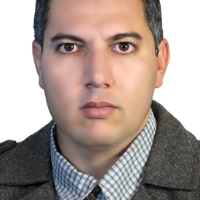Investigating the spatial resolution of actual evapotranspiration maps in the ZayandehRud basin
Evapotranspiration is one of the most important parts of the water cycle (Boegh and Soegaard 2004). Precise prediction of actual evapotranspiration () is essential for various fields, such as agriculture, water resource management, irrigation planning and plant growth modeling. Therefore, accurate determination of actual evapotranspiration has always been a major concern of experts in these fields. Due to the limited number of weather stations and the fact that collecting ground information is both time consuming and expensive, remote sensing and satellite imagerycan be a suitable tool in determination of actual evapotranspiration (Brisco et al., 2014). Satellite productions are usually divided into images with low, medium and high spatial resolution (Rao et al., 2017). Surface energy balance is a method usually used in combination withremotely sensed spatial data for estimation. Information collected from various sources, such as remotely sensedimageries and meteorological data, are used in this method. The present studyinvestigatesspatial distribution on different scales (from field- to regional-) using remotely sensed imagerieswithdifferent spatial and temporal resolution. TheSurface Energy Balance System (SEBS) is one of the most important methods used for the estimation of in remotely sensed images (Ochege et al., 2019). This model needs thermal maps produced using satellite images. Daily maps produced with RS are usually very large, and their pixelsize is usually so large that it can provide the spatial diversity found in the basins with respect to the errors (Mahour et al., 2017).
In order to estimate the actual evapotranspirationin satellite images collected from Zayanderud basin,the effects of Co-Kriging downscaling of surface temperature (LST) were investigated in June 2017 using two different methods.To reach this aim, we first applied a co-kriging downscaling method to a low-power LST product collected from MODIS at 1000 meters. Then based on the results and using the SEBS system, the daily was obtained from images with average spatial resolution (250 m).In the second method, map produced usinghigh resoultion satellite imageswas downscaled to medium resolution (250 m). For both methods, 250 m resolutionMODIS NDVI products were used as co-variables.Then, validation was performed using Landsat-8 imagery, and land surface temperature was extracted from its thermal bands. SEBS algorithm was used to determine in Landsat 8 30-meter resolutionimagery. Accuracy of measurements wasexamined based on a comparison between down scaledLST and maps (250 meterresolution).
In the present study, mean LST equals 3/312 K (SD = 1.74) and average daily equals 12.5 mm / day (SD = 0.86). In the downscaling phase, the relationship between LST parameters and and vegetation index(as a co-variable)was investigated.Moreover, to investigate the relation betweenhigh resolution variables and NDVI, we re-sampled LST and variables from a 1000 mresolution to 250 mresolution.In250 mresolution, there is a negative linear relation (r=-0.85) between LST and NDVI, but the relation betweenand NDVI is positive (r = 0.80). Thus, lower LST (> 305k) indicates more vegetation (NDVI >0.3) inthe region, while higher LST results in lower NDVI or lack of vegetation. As a result, more vegetation can be observed in regions with higher(12 mm/day). Results indicated that the difference between average downscaled-SEBS (12.56 mm/day) and reference (13.11 mm/day) is negligible. The RMSE between the reference and the downscaled equaled 1.66 mm/day (r = 0.73), and RMSE between the reference LST and the downscaled LST equaled4.36 K (r = 0.78). Thus,values obtained from two downscaling methods were similar, but the obtained from downscaled LST showed a higher spatial variation. Therefore, LST has greatly influenced the production of maps using remotely sensing images, and Co-Kriging downscaling has been useful for providing daily maps with intermediate spatial resolution.
Evapotranspiration downscaling using the co-kriging method is not significantly different from the SEBS product and the results are similar. The results of -SEBS method isalso acceptable, but the derived from the SEBS algorithm is more variable due to the LST downscaling.
- حق عضویت دریافتی صرف حمایت از نشریات عضو و نگهداری، تکمیل و توسعه مگیران میشود.
- پرداخت حق اشتراک و دانلود مقالات اجازه بازنشر آن در سایر رسانههای چاپی و دیجیتال را به کاربر نمیدهد.




